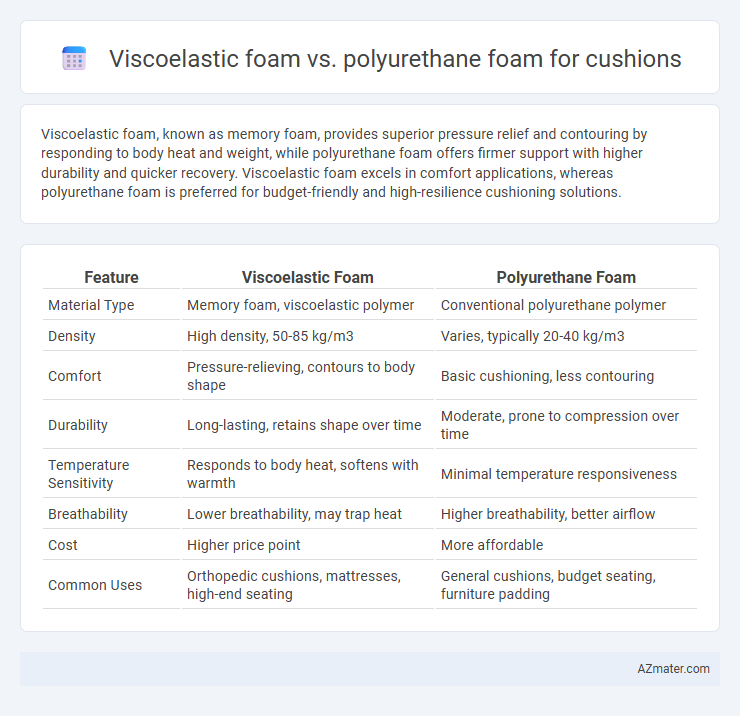Viscoelastic foam, known as memory foam, provides superior pressure relief and contouring by responding to body heat and weight, while polyurethane foam offers firmer support with higher durability and quicker recovery. Viscoelastic foam excels in comfort applications, whereas polyurethane foam is preferred for budget-friendly and high-resilience cushioning solutions.
Table of Comparison
| Feature | Viscoelastic Foam | Polyurethane Foam |
|---|---|---|
| Material Type | Memory foam, viscoelastic polymer | Conventional polyurethane polymer |
| Density | High density, 50-85 kg/m3 | Varies, typically 20-40 kg/m3 |
| Comfort | Pressure-relieving, contours to body shape | Basic cushioning, less contouring |
| Durability | Long-lasting, retains shape over time | Moderate, prone to compression over time |
| Temperature Sensitivity | Responds to body heat, softens with warmth | Minimal temperature responsiveness |
| Breathability | Lower breathability, may trap heat | Higher breathability, better airflow |
| Cost | Higher price point | More affordable |
| Common Uses | Orthopedic cushions, mattresses, high-end seating | General cushions, budget seating, furniture padding |
Introduction to Cushion Foam Types
Viscoelastic foam, also known as memory foam, offers superior pressure relief and contouring by responding to body heat and weight, making it ideal for cushions requiring enhanced comfort and support. Polyurethane foam, a versatile and cost-effective material, provides varying densities and firmness levels suited for general cushioning needs with durability and resilience. Choosing between viscoelastic and polyurethane foam depends on factors such as desired comfort, support, budget, and application specifics.
What is Viscoelastic Foam?
Viscoelastic foam, commonly known as memory foam, is a temperature-sensitive material that softens and molds to the body's shape, offering superior pressure relief and comfort compared to traditional polyurethane foam. Unlike polyurethane foam, which is more resilient and bounces back quickly, viscoelastic foam has a slow recovery rate, enhancing support by evenly distributing weight and reducing motion transfer. This unique viscoelastic property makes it ideal for cushions in mattresses, chairs, and medical applications where comfort and durability are essential.
What is Polyurethane Foam?
Polyurethane foam is a versatile, lightweight material commonly used in cushions due to its excellent support and durability. It is created through the reaction of polyols and diisocyanates, resulting in a flexible, open-cell structure that adapts to pressure while maintaining its shape. Compared to viscoelastic foam, polyurethane foam offers faster resilience and a more affordable cushioning solution without compromising comfort.
Key Differences Between Viscoelastic and Polyurethane Foam
Viscoelastic foam, also known as memory foam, is highly responsive to body heat and pressure, offering superior contouring and pressure relief compared to polyurethane foam, which is generally firmer and less adaptive. Polyurethane foam is more breathable and affordable, making it a common choice for budget cushions, whereas viscoelastic foam excels in comfort and support, ideal for prolonged use or therapeutic applications. Durability is another key difference; viscoelastic foam tends to maintain its shape longer, while polyurethane foam may degrade faster under constant use.
Comfort and Support Comparison
Viscoelastic foam, commonly known as memory foam, offers superior comfort by conforming to body shape and providing pressure relief, making it ideal for personalized support. Polyurethane foam is typically firmer and more resilient, delivering consistent support but less contouring, which can result in a bouncier feel. For cushions, viscoelastic foam excels in reducing pressure points and enhancing comfort, while polyurethane foam is better suited for durability and structural support.
Durability and Longevity
Viscoelastic foam offers superior durability compared to traditional polyurethane foam, maintaining its shape and support over extended use without significant sagging or deformation. Polyurethane foam typically deteriorates faster due to its open-cell structure, which is more prone to compression and breakdown under continuous pressure. High-density viscoelastic foam can last up to twice as long, making it a preferred choice for cushions requiring long-term resilience and comfort.
Pressure Relief Capabilities
Viscoelastic foam, commonly known as memory foam, offers superior pressure relief by contouring closely to the body's shape, evenly distributing weight, and reducing pressure points. In contrast, polyurethane foam provides moderate pressure relief but lacks the adaptive, slow-recovery characteristics of viscoelastic foam, which limits its effectiveness in minimizing localized stress. For cushions focused on pressure relief, viscoelastic foam consistently outperforms polyurethane foam by promoting better blood flow and reducing discomfort during prolonged sitting.
Breathability and Temperature Regulation
Viscoelastic foam offers superior breathability and temperature regulation due to its open-cell structure that promotes air circulation and dissipates heat efficiently. Polyurethane foam tends to retain more heat because of its denser, closed-cell composition, which limits airflow and can lead to increased perspiration during prolonged use. For cushions requiring enhanced cooling and moisture-wicking properties, viscoelastic foam is often the preferred choice.
Cost Comparison: Viscoelastic vs Polyurethane Foam
Viscoelastic foam generally costs significantly more than polyurethane foam due to its advanced material properties and memory foam technology. Polyurethane foam remains a budget-friendly option, widely used in cushions for its lower price point and satisfactory comfort levels. The cost difference is justified by viscoelastic foam's superior pressure relief and durability, making it a premium choice for cushioning applications.
Choosing the Best Foam for Your Cushion Needs
Viscoelastic foam, also known as memory foam, offers superior contouring and pressure relief, making it ideal for cushions requiring enhanced comfort and support. Polyurethane foam provides greater durability and firmness, suitable for cushions that need to maintain shape under frequent use. Selecting the best foam depends on balancing comfort preferences with longevity requirements for your specific cushion application.

Infographic: Viscoelastic foam vs Polyurethane foam for Cushion
 azmater.com
azmater.com